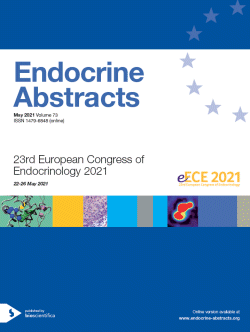
European Congress of Endocrinology 2021
Online
22 May 2021 - 26 May 2021
Oral Communications
Oral Communications 12: Diabetes, Obesity, Metabolism and Nutrition
ea0073oc12.1 | Oral Communications 12: Diabetes, Obesity, Metabolism and Nutrition | ECE2021
Prevention of glucocorticoid-induced adipose dysfunction through selective activation of β3-adrenergic signaling in mice
Gado Manuel , Heinrich Annett , Wiedersich Denise , Noll Monique , Bornstein Stefan R. , Rauner Martina , Hofbauer Lorenz C. , Henneicke Holger
ea0073oc12.2 | Oral Communications 12: Diabetes, Obesity, Metabolism and Nutrition | ECE2021
Improved glucose metabolism and decreased weight gain in leptin-resistant, IGFBP2-deficient, db/db mice induced by AZP-3404, a 9-amino acid analog of IGFBP2
Culler Michael D. , Milano Stéphane , Ovize Michel , Delale Thomas , van der Lelij Aart Jan , Clemmons David
ea0073oc12.3 | Oral Communications 12: Diabetes, Obesity, Metabolism and Nutrition | ECE2021
Comparative evaluation of empagliflozin, canagliflozin and sitagliptin cardioprotective effect in diabetic rats with experimental myocardial infarction
Simanenkova Anna , Minasian Sarkis , Karonova Tatiana , Vlasov Timur , Timkina Natalya , Khalzova Aleksandra , Shpilevaya Oksana , Shimshilashvili Anzhelika , Timofeeva Valeria , Borshchev Yury , Galagudza Mikhail
ea0073oc12.4 | Oral Communications 12: Diabetes, Obesity, Metabolism and Nutrition | ECE2021
Improvements in long-term appetite-regulating hormones in response to a combined lifestyle intervention for obesity
Kuckuck Susanne , van der Valk Eline S. , Scheurink Anton J. W. , van den Berg Sjoerd A. A. , van Rossum Elisabeth F. C.
ea0073oc12.5 | Oral Communications 12: Diabetes, Obesity, Metabolism and Nutrition | ECE2021
Effects of the ghrelin gene-derived peptides on adipose browning and thermogenesis
Congiusta Noemi , Gesmundo Iacopo , Pagliaro Pasquale , Ghigo Ezio , Penna Claudia , Granata Riccarda
ea0073oc12.6 | Oral Communications 12: Diabetes, Obesity, Metabolism and Nutrition | ECE2021
Molecular and functional mapping of POMC neuronal heterogeneity in obesity
Léon Stéphane , Simon Vincent , Clark Samantha , Dupuy Nathalie , Cota Daniela , Quarta Carmelo



